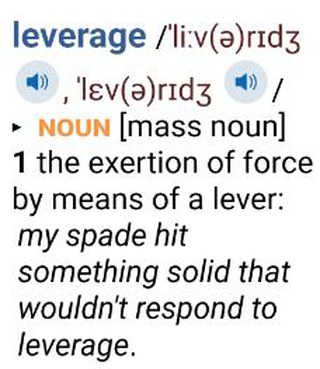Has the concept of “leverage” had its day? Dr. Marsha Dickson
Recently I was reminded of the concept of leverage, promoted in the UN Guiding Principles for Business and Human Rights and adopted into the OECD’s Due Diligence Guidance for Responsible Business.
The idea that businesses should obtain, and use leverage over their suppliers to ensure workers in supply chains are protected, and paid and treated fairly, was first introduced in 2011 by John Ruggie and his team when they were creating the Guiding Principles.
Back then, I, like many others, was a firm believer.
But now, it strikes me that the idea is no longer fit for purpose, and the time has come for a new way forward to secure human rights for workers.
I looked up the definition of leverage from Oxford Languages that supports Google in its English definitions:
the exertion of force by means of a lever or an object used in the manner of a lever.
“my spade hit something solid that wouldn’t respond to leverage”
The idea of leverage perpetuates the power differential in global supply chains, where buyers who have significant power of influence over their suppliers, are expected to use that power in a forceful way to make suppliers take action. The assumption is that it’s suppliers that stand in the way of decent work for their employees. But how does this fit with the current cry for more collaborative relationships between buyers and suppliers and for buyers to treat suppliers with more respect and as equal partners? And a CSDDD framework that companies will not be able to comply with unless they have 360-degree visibility of their operations, subsidiaries, and value chain?
It doesn’t. Maybe instead of buyers using leverage, they can collaborate as true partners with their suppliers to identify why problems continue to exist, create shared goals for what can be achieved, and develop shared plans for achieving those goals.
Think about it. The term “partnership” can be easily substituted for some of the actions proposed that involve a business securing or using leverage. It’s also much more actionable by brands and retailers than the somewhat blunt and subjective concept of “leverage”, especially given that, in the 13 years since the UN Guiding Principles were born, we’ve done extensive work with suppliers and brands to define what true partnership looks like. We have clear frameworks for partnerships in the Five Principles of Responsible PurchasingTM and the Common Framework for Responsible Purchasing, and an established mechanism for suppliers to feed back to their brand and retailer customers on the quality of their partnerships in the Better Buying Partnership IndexTM.
Let’s play around with ways in which we could substitute ‘partnership’ for leverage’ in the OECD Guidelines. Here are just two examples:
- Use (LEVERAGE) PARTNERSHIP to mitigate any remaining impacts to the greatest extent possible.
- Use (LEVERAGE) PARTNERSHIP to influence the entity causing the adverse impact to prevent or mitigate the impact.
It works, doesn’t it? And by making this small but significant change, buyers are offered ideas as to how they can use their partnership with their suppliers to prevent and mitigate impacts or address a lack of partnership that’s preventing them from doing that.
What if the UN Guiding Principles were updated to say, ‘Leverage PARTNERSHIP is considered to exist where the enterprise has BUYERS AND SUPPLIERS HAVE the ability to effect change in the wrongful practices of an entity the entities that causes a harm.’
Of course, it will take more than a simple cut and paste to fundamentally shift the way buyers think about their supply chain partners. We need thoughtful conversations about whether the best avenue to engage suppliers is through the force of big buyers (or multiple buyers ganging up) or the engagement of suppliers as equal partners in collaborative business relationships that result in good, mutually beneficial outcomes.
Shifting from leverage to partnership as a foundational means for human rights in supply chains would surely drive and incentivize buyers to make a lot more effort to improve their purchasing practices, and to have honest and constructive conversations with their suppliers in relation to how to achieve that.
We’ve come a long way in the years since the UN Guiding Principles came into effect. Back in 2011, only a handful of actors were talking about the benefits of buyers and suppliers collaborating as equal partners, to achieve shared business and sustainability goals and to improve the lives and livelihoods of workers. Now, they’re widely accepted and understood.
Maybe this momentum toward collaborative supply chains is what we can leverage!

